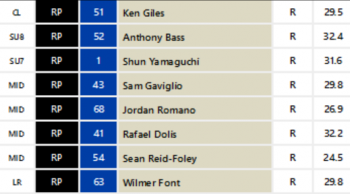Rick Lucks takes a deep look into the prospects of SP/RP Freddy Peralta (Milwaukee Brewers) and RP Ken Giles (Toronto Blue Jays) in fantasy baseball redraft leagues for 2020. Do they project to provide value based on current ADP?
The conventional fantasy wisdom this season seems to be that you need to devote a lot of draft resources to pitching. The logic goes that ace starters are so much better than other arms that you need to have at least one before the end of the third round in standard 12-team leagues. Furthermore, experts are advising to grab at least one closer early since saves are so volatile. You've got to have some on your Opening Day roster, right?
Such a strategy is certainly viable, but this author doesn't believe that it is the only way to compete in 2020. There are plenty of enticing pitchers who could produce premium pitching stats without the premium price tag of a Jacob deGrom or Gerrit Cole. Similarly, you can grab a safe, reliable closer outside of the top 100 who has the upside for much more.
This column will take a closer look at two pitchers: one SP (Freddy Peralta) and one RP (Ken Giles). Let's get to it!
Freddy Peralta (SP/RP, MIL)
ADP: 361.8
Peralta had a solid 7-3 record at the MLB level, but his 5.29 ERA in 85 IP wasn't really what fantasy owners are looking for. His price tag suggests that a lot of owners are looking at that ERA and running away. However, his xFIP was a much more respectable 4.15, and his 30.1 K% was healthy enough to generate fantasy value even if his ERA is on the higher side.
Peralta's style is unconventional, but the strikeouts look real. He threw his four-seam fastball 78.4% of the time last year, and it's one of the best fastballs in the majors. Its velocity jumped relative to 2018 (91.4 mph vs. 94.1), helping it to post a 14 SwStr% and 57.7 Zone%. It also boasts a high spin rate (2,454 RPM), most of which contributes to significant rising action (80% Active Spin). As a result, it induces a lot of fly balls (40.9 FB%) and pop-ups (36.1 IFFB%).
Peralta allowed a .338 BABIP last season, but his signature pitch's propensity for pop-ups would seem to limit it moving forward. Likewise, his 64.8% strand rate is very low for a pitcher with such a high K rate. Metrics like these aren't always luck-based, but they certainly appear to be in Peralta's case.
Peralta's problem is that he really doesn't have a second pitch, much less a third. While he threw his curve 20.4% of the time, it was inferior to his heater in every way imaginable (10.1 SwStr%, 38.8 Zone%, 29.5% chase rate). The rest of his arsenal is thrown so infrequently that it effectively doesn't exist. If Peralta could find something for his fastball to work off of, he'd be an instant ace.
His role is also somewhat in the air at the time of writing, but there is one key piece of evidence that suggests it will be fantasy relevant. The Milwaukee Brewers have to be ranked as one of the smartest front offices in the game today, and they decided to lock up Peralta with a five-year, $15.5 million contract extension back in February. Whether they see him as a traditional closer who can free up Josh Hader to work more innings or as a rock in their rotation, Peralta is too cheap for the talent he possesses.
Verdict: Champ (based on one of the league's best fastballs and the team's confidence in him)
Ken Giles (RP, TOR)
ADP: 123.4
Giles was sensational in 2019, posting a 1.87 ERA and 2.73 xFIP with a 39.9 K% in 53 IP. Closers have three jobs in fantasy: Help with ratios, help with strikeouts, and compile saves. Giles is elite in all three categories.
It's tough to project any pitcher for a sub-2 ERA, but even Giles's xFIP would provide the ratio help fantasy owners want from an elite reliever. Similarly, his strikeouts are the result of roughly a 50/50 split between his fastball and slider. His fastball is everything you want from a heater: strong SwStr% (10.2% last year) and strong Zone% (55.6%). His slider is an excellent wipeout pitch (27.6 SwStr%, 36.3 Zone%, 46.9% chase rate) that allows Giles to put away batters at will. Together, they form a nasty one-two combination.
Perhaps most importantly, Giles may have the most job security in baseball. Here is the Toronto bullpen as projected by RosterResource:
That is not an impressive list of names. Both Anthony Bass and Shun Yamaguchi are over 30 years old and don't have anywhere near the track record to unseat Giles. Furthermore, Toronto has an above-average but not elite offense and a competent starting rotation. They figure to participate in a lot of close games that should provide Giles with plenty of save opportunities.
Few pitchers offer Giles's strikeouts and saves. Pitchers like Hader and Nick Anderson get the Ks, but their ability to work multiple innings discourages their use as traditional closers. Meanwhile, pitchers like Roberto Osuna and Aroldis Chapman either no longer have the same level of strikeout stuff or pitch in such great bullpens that their managers don't have to rely on them as much. Take Giles as your first reliever, and your bullpen won't miss a beat.
Verdict: Champ (based on draft cost and elite production)





 RADIO
RADIO

























